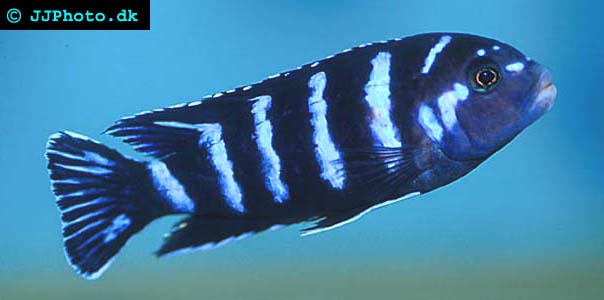Pseudotropheus introduction
Pseudotropheus is the name of a large and diverse genus in the family Cichlidae. All Pseudotropheus species hail from Lake Malawi in eastern Africa. Many species that used to be considered members of the genus Pseudotropheus have today been moved to other genera, such as Maylandia and Metriaclima. Lake Malawi is famous for its diverse fauna and abundance of cichlid species. Cichlids have developed to fit into a large variety of ecological niches in the lake. Lake Malawi is located on the African continent and is shared by three countries: Malawi, Mozambique and Tanzania. The lake is 560 km long and 75 km wide at the widest point, which gives a total surface area of nearly 30,000 square kilometres. Ruhuhu is the name of Lake Malawi's largest tributary and the Shire River is the principal outlet. Young Malawi is a comparatively young lake and was probably formed 40,000 years ago.
The cichlids in Lake Malawi are divided into two groups: Haplochromine cichlids (also known as Peacocks or simply “Haps”) and Mbuna cichlids. The Pseudotropheus species belong to the Mbuna group. Mbuna is a word borrowed from one of the local languages spoken around lake Malawi, and means “rock-dweller”. A Mbuna cichlid is typically smaller than a Haplochromine cichlid, and male as well as female Mbunas show striking colours.
Just like the other Mbunas, Pseudotropheus cichlids need a rocky setup in the aquarium to feel at home. A lot of hiding places among the rocks are necessary to relieve stress. In the wild, most Pseudotropheus species feed on algae and should be provided similar food types when kept in aquariums. There are however exceptions and it is advisable to research the particular Pseudotropheus species that you intend to keep to find out what it eats in the wild.
You should ideally use an aquarium that is already mature to place your Pseudotropheus cichlids in, preferably one that has already been inhabited by other fish. If you set up a new aquarium for the Pseudotropheus and want the aquarium to mature faster, you can add a rather large amount of mature filter from another aquarium. Mature filter will speed up the process significantly. It is imperative that the water in the old aquarium has a chemistry similar to the one suitable for Pseudotropheus cichlids. Add all your Pseudotropheus cichlids simultaneously, otherwise the first ones will establish territories and harass any newcomers. If you are unable to add all fish simultaneously, at least add them in groups consisting of six fishes or more. Never add just a few fishes to the Pseudotropheus aquarium. By adding at least six fishes the aggression from the old inhabitants will be spread over more individuals. You should also rearrange the aquarium décor before you add new fish, to break up the claimed territories. Distracting the old inhabitants with food when you introduce the new fish is also recommended.

Pseudotropheus demasoni – A Pseudotropheus Cichlid. Copyright www.jjphoto.dk
Male Pseudotropheus are highly territorial and should not be kept together in the same aquarium. Keeping one male with several females is the best combination. Even though Pseudotropheus cichlids are aggressive, some of them can be included in a mixed aquarium with species capable of fending for them selves. Since Pseudotropheus is such a diverse genus, the temperaments vary a lot between different Pseudotropheus species. Two examples of the most docile Pseudotropheus species are Pseudotropheus demasoni and Pseudotropheus saulosi. Among the most aggressive Pseudotropheus species are those in the Pseudotropheus elongatus group. A large aquarium will mean a lot less fighting regardless of which Pseudotropheus species you keep. Always keep the aquarium well stocked to reduce the amount of aggressive behaviour experienced by each individual fish.
Didn't find the info you were looking for? Register for free and ask your question in our Aquarium forum !
Our knowledgeable staff usually responds to any question within 24 hours
Related Articles
Aulonocara - Information about AulonocaraBreeding Aulonocara - Information about Breeding Aulonocara
Breeding the Sulphur-Crested Lithobate: Otopharynx lithobates - A detailed article about breeding this Lake Malawi mouthbrooder, together with some useful general tips.
Haplochromis - Information about Haplochromis
Home-made Rocks for the Mbuna Aquarium - A guide to help you mad home made rocks for your Mbuna aquarium.
Keeping Pseudotropheus - Information about Keeping Pseudotropheus
Malawi Cichlids - Information about Malawi Cichlids
Pseudotropheus - Information about Pseudotropheus
Breeding Pseudotropheus - Information about Pseudotropheus Breeding
Fish News
Aquarium Forum
Calculators
Free Aquarium Ebook
Feedback
Fish Anatomy
Link to us
Photo gallery
Plant species
Tropical fish species
By Common name
By Scientific name
Tropical Marine fish
By Common name
By Scientific name
Algae Control
Aquarium Decoration
Aquarium Resources
Aquatic Plants
Barb Fish
Betta Fish
Breeding Fish
Catfish
Central American Cichlids
Cichlids
Clownfish
Corals
Corydoras Catfish
Discus Fish
Dwarf Cichlids
Fish Diseases
Frogs and Turtles
Goby Fish
Goldfish
Gourami
Invertebrates
Jellyfish
Killiefish
Lake Victoria Cichlids
Livebearers
Malawi Cichlids
Marine Aquariums
Marine Aquarium Fish
Other Fish
Pleco
Predatory Fish
Photography
Pond Fish
Responsible Fish Keeping
Rainbow Fish
Shark Fish
South American Cichlids
Tanganyika Cichlids
Tetra Fish
Tropical Fish Food
